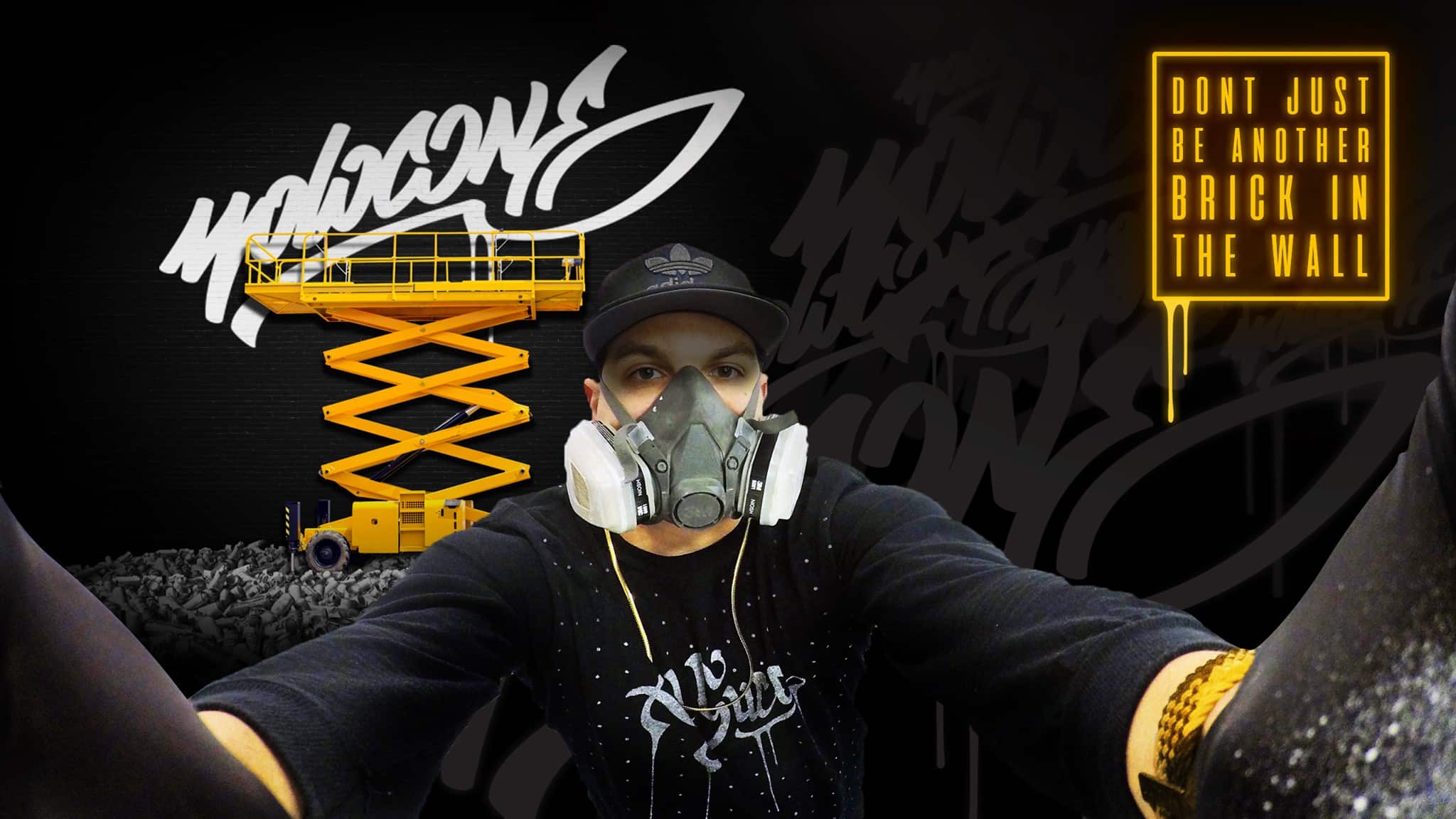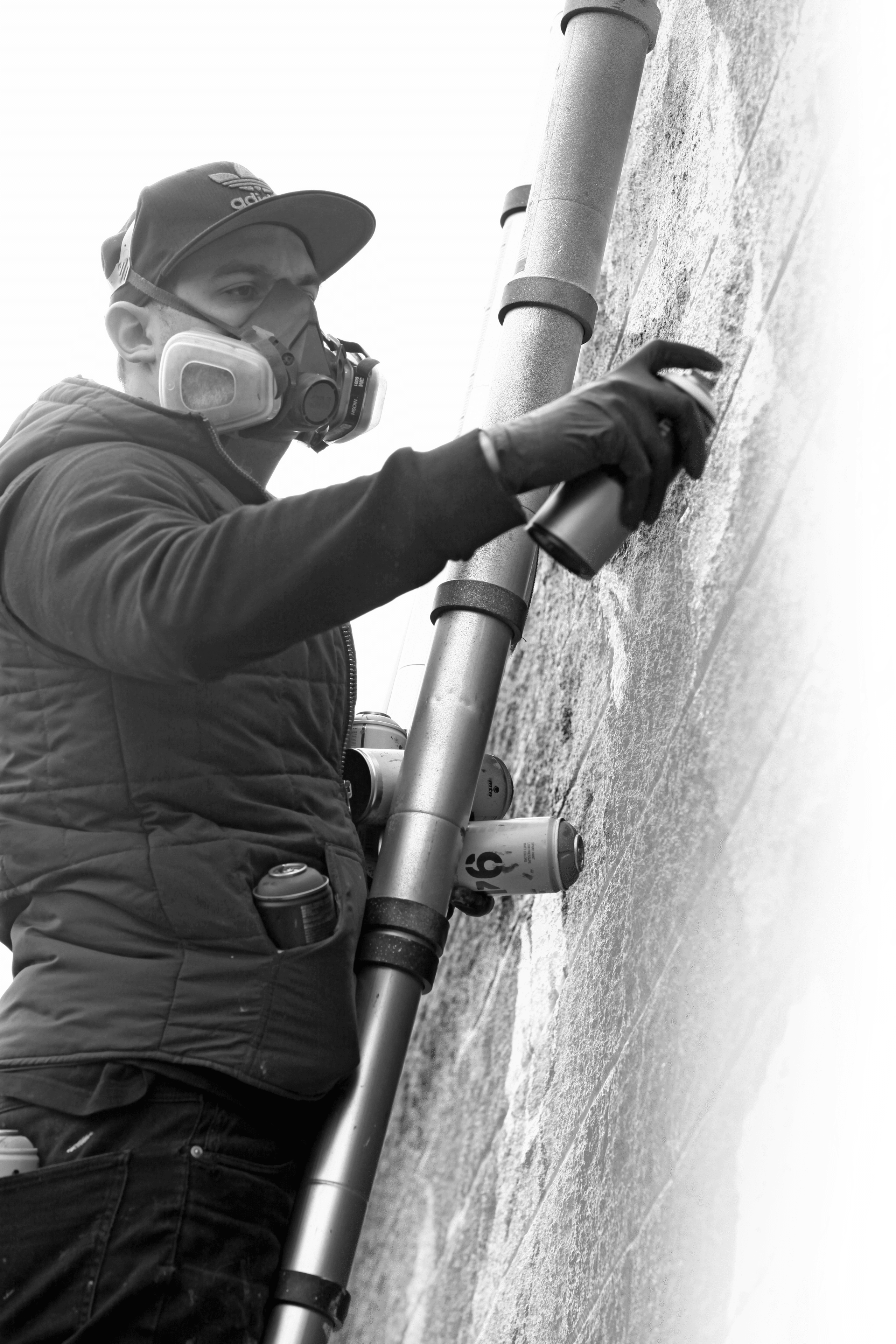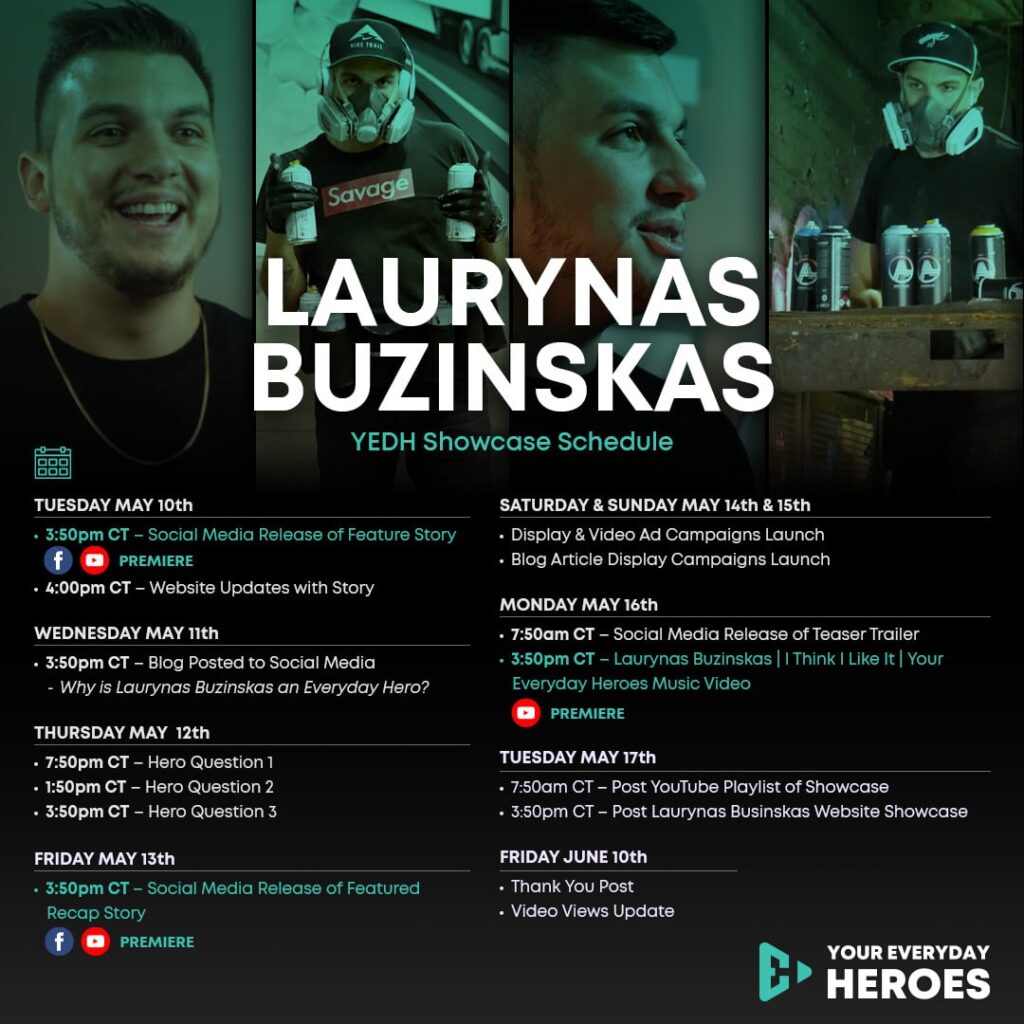Your Everyday Heroes has been proud to spotlight the inspiring story of spray paint graffiti writer Laurynas Buzinskas. We were drawn to him not only because of his obvious talent in graffiti tagging, but because of his ability to turn his once-illegal passion into a legitimate career.
We believe that a great deal of our audience will relate to his story, and we hope you come away from it with a greater drive to fulfill your own destinies.

It is not his graffiti tagging skill that makes Laurynas an everyday hero. It is what he uses his skill for. He paved his own way, never giving up on his dream even when it seemed like his naysayers were right.
Before getting into his story, we’d like to plug his company Yolocone Graphics. Take one look at the linked portfolio, and you’ll have a good idea of what Laurynas is capable of as a graffiti writer. You can stay up to date with his work via Instagram and Facebook.
A Portrait of the Graffiti Writer as a Young Man
For Laurynas, getting to where he is now was no easy process, especially considering the inherent risk of his passion: spray paint graffiti. As a youth in Vilnius, Lithuania, he would stay out all night honing his graffiti tagging, living a fast life that seemed like it could only end badly. And it almost did. After graffiti tagging trains with his friend, Laurynas caught a case that nearly landed him two years in prison, something he was thankfully able to avoid.


While many would view this instance as a failure, Laurynas chose to use it as an opportunity to turn his life around. But how could he walk on the right side of the law when his love was something that violated it? Not sure what to do with his life, he attended art school.
While he wasn’t expecting much from college, he was shocked at how much it changed him. With academic training, he was able to bring to life the art he had in his head. Suddenly, his skillset was no longer limited to graffiti tagging. He could paint beautiful murals that still managed to incorporate the spray paint graffiti elements that he initially fell in love with.
Before long, he landed a job as a graphic designer in Lithuania, finally getting paid to make art. However, Laurynas has never been one to limit himself. He wanted to move to the U.S., to see in-person where graffiti originated. Convinced that his experience as a graphic designer would get him a steady job in the arts, he headed for Chicago. However, he soon found out the American dream isn’t all it’s made out to be.

Laurynas Comes to America
One of the most heroic aspects of the graffiti writer’s story is his refusal to give up. His first few years in the US presented the greatest challenges to his drive. Perhaps, he thought, his parents and teachers were right; perhaps art was a fruitless endeavor. But as you will see, these intrusive thoughts didn’t stop him.
Despite his talent as a graffiti writer, Laurynas spent his first four years in the U.S. working odd jobs to survive, using his free time to further develop his skills as an artist, as well as to apply to graphic design jobs, which were much harder to get in the US than in his home country.

His hard work eventually paid off. He landed a full-time job as a graphic designer for an advertising company. He was finally able to return to making a living off of his art.
Once again, however, Laurynas strived for something greater. While he was happy to work in the graphic design field, he didn’t truly feel free. As a side hustle, he formed his own company Yolocone Graphics: under Yolocone Graphics, he was able to take commissions, set his own prices, and have more creative control over his work as a graffiti writer.
And while graphic design is something that Laurynas is skilled at, Yolocone also allowed him to take on mural work, his true passion. Take a look at the company’s portfolio, and you will see the full extent of Laurynas’s talent.
Over the course of several years, Yolocone went from being Laurynas’s side hustle to his main source of income. With mural art now being his primary job, he is finally able to thrive off his passion for graffiti in a manner that is safe, legal, and most of all, lucrative.
“I feel free,” he tells Your Everyday Heroes.
What Makes Laurynas an Everyday Hero?
Laurynas’s story is one of hard work, perseverance, and above all redemption. He went from facing years in prison to becoming a respectable entrepreneur. What’s more is he did it by utilizing the same skills that once got him in trouble with the law.
Watch More Inspirational Everyday Heroes Stories
There are thousands upon thousands of truly talented graffiti artists. What sets Laurynas apart is the fact that he found a way to legalize his passion. Was it ever easy? No, not in the least. For many artists, creating is merely a phase that’s given up when they realize the difficulties of profiting off art. Others understandably burn out when it becomes too difficult to balance a normal job with their hobby.

For Laurynas, however, creating has always been a need. And with his level of determination, he was bound to get to where he is today sooner or later. He hopes that his story can inspire other aspiring artists, particularly those in the world of graffiti, who may believe that they will never find a way to “legitimize” their art.
History Of Graffiti Writing
Graffiti writing is one of the oldest forms of art, with its origin beginning on the walls of caves thousands of years ago, and later in ancient Egypt, Greece, and the Roman Empire. Ancient graffiti included alphabets, love declarations, insults and political slogans.
Modern graffiti eventually gave birth to “monikers” which taggers used to identify themselves. The earliest recorded usage was in the 1800’s when hobo and rail workers tagged train cars. The phrase “Kilroy was here” along with an illustration, appeared all over Europe due to American troops tagging buildings during WWII.
In the 1960’s and 1970’s, the invention of aerosol paint created an uptick in graffiti world-wide. The rise of hip-hop culture and anti-establishment punk rock saw names and logos appear throughout the world, particularly in the United States, where graffiti writing was used as a popular form of expression by political activists and gangs.
Philadelphia, Pennsylvania and Boston emerged as the contemporary focus of spray paint graffiti in the United States, but New York City soon became a modern hub for graffiti art on city streets and subways.
During the 1970’s, graffiti exploded in popularity as an art form and the competition amongst graffiti taggers drove an explosion of cramming as many tags into one area as possible, which resulted in bolder pieces that increased in size and thickness to span entire subway cars.
Because of the significant uptick in graffiti tagging, New York’s Metropolitan Transit Authority (MTA) began to remove spray paint from the buildings and subway cars that were being vandalized. By the early 1980’s the MTA was on the way to eradicating street graffiti, the penalties for getting caught got tougher, and the population of graffiti taggers was in decline.
Eventually, in the late eighties, street artists began to bring their work to galleries, when Jean-Michel Basquiat and Keith Haring became reputed artists.
Perhaps the most popular graffiti artist on in the world is Banksy, an anonymous English tagger, who has kept his identity under wraps since launching his career in 1991. By 2002, Banksy began exhibiting in art galleries, and soon rose to prominence with his public “installations” appearing on walls and bridges all over the world.
Conclusion
It is not enough to merely have a dream. One must put in the effort to accomplish it. Everyone’s a dreamer to some extent. But Laurynas is a doer. Even while working dead-end jobs, he found time to do what he loves: being a graffiti writer. There were days when his endeavors felt hopeless. But with such a burning passion for art, how could he possibly give it up? And as it usually does, his hard work paid off.